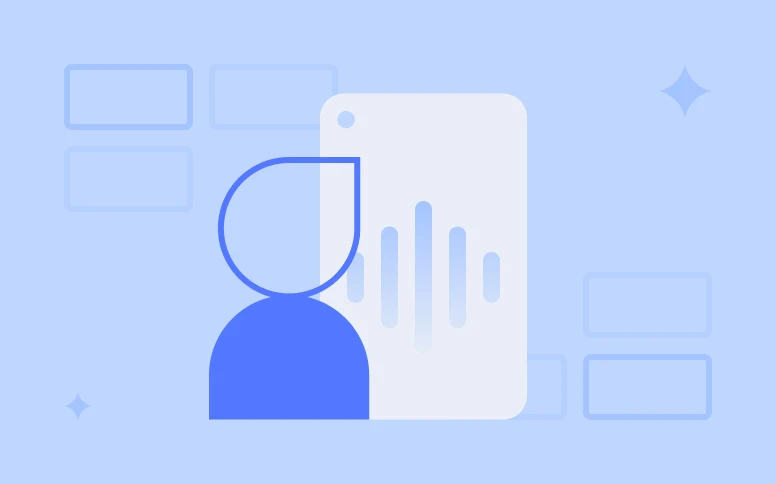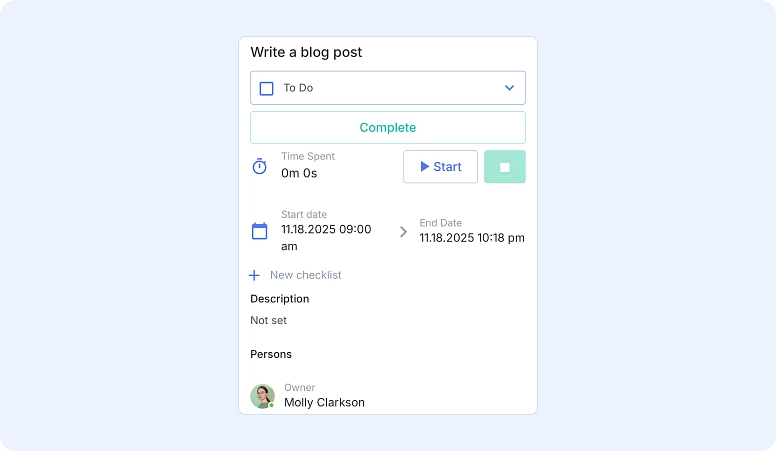AI Voice Task Creation in the Flowlu Mobile App
Ideas rarely wait for the perfect moment. They show up when you’re walking, in transit, or mid-discussion. Thinking of a task is easy; keeping it in your head long enough to write it down isn’t.
To help you capture tasks more quickly, the Flowlu mobile app now lets you create them with your voice using AI.
How it works
You speak, the app listens, and the AI builds a structured task out of your voice input. It fills in key fields automatically:
- Task name
- Description
- Assignee
- Followers and collaborators
- Deadline
- Project link
Say something like:
“Create a task to review the campaign brief, assign to Kelly Anderson, add Anna Mackay as a follower, deadline next Tuesday, link it to the Marketing Updates project.”
Flowlu will fill everything in automatically.
You’ll find this feature on iOS, Android, and tablet versions of the app.
Why it’s a must-have
Typing on a phone can be slow, especially when you’re moving around or switching between tasks. Speaking is quicker and lets you capture what needs to be done without interrupting what you’re already doing.
This feature helps when you:
- Need to record tasks away from your desk
- Want to add longer descriptions without typing
- Pass tasks to teammates during busy moments
- Prefer speaking instead of tapping on a screen
AI voice task creation closes the gap between “I should write this down” and having the task already saved in Flowlu.
How to access AI Voice Task Creation on your phone
You can open this feature directly from your phone’s home screen:
1. Find the Flowlu app icon.
2. Tap and hold the app until the quick menu appears.
3. Select Open AI Form — Voice Task Creation.
4. Flowlu will open the homepage and auto-fill the field at the bottom of the screen with what you’re saying in that moment.
5. Speak your task, then tap Send when you’re done.
6. Flowlu will create the task based on everything you said.
How to create a task using voice commands
To help you get the best results, here’s a simple guide to structuring your voice command:
1. Start with a clear beginning
Use phrases like “Create a task…”, “Add a task…”, or “We need to…”.
2. Specify the person responsible
- “to [Name]” or “assign to [Name]”
- If it’s for you: say “to me” or “assign to me”
3. Add collaborators if needed
- The first name is the assignee
- Additional names are collaborators
- You can say: “and [Name2]” or “collaborator [Name2]”
4. Add followers
- Say “followers” or “follower will be…”
- Then list: “followers [Name3] and [Name4]”
5. Mention the project
- At the beginning: “Create a task in the [Project Name] project…”
- Or at the end: “…link to project [Project Name]” or “attach to [Project Name]”
6. Describe the task
A short action phrase is enough: “test the new UI,” “prepare the report,” “review the draft,” etc.
7. Set the deadline
Examples:
- “deadline tomorrow at 6 p.m.”
- “by Friday”
- “by the end of the day”
8. Start date
If you don’t mention it, it defaults to now.
9. Anything else
Any details you don’t categorize will be added to the task description.
Example 1:
“Create a task in the Marketing project to test the new UI, assign to me, follower John Lynes, deadline tomorrow at 6 p.m.”
Example 2:
“Add a task for me and Collin Woolf: collect data, link to the Development project, collaborators Evelyn Gibson and James Mason, followers Charlotte Russell and William Simons, deadline the day after tomorrow.”
You can also access similiar guide by tapping the little question-mark button in your input field.
Try it out
Now you can keep your tasks on track with a single sentence! Give it a try and share your feedback — we’re already working on the next round of AI updates, and your input helps us fine-tune them.
Using the simple structure we outlined helps the AI understand your task faster. The good news is that it’s easy to remember—after doing it once or twice, you’ll find yourself using it automatically without thinking about it.
Nothing breaks. Any details you leave out will simply go into the task description, and you can adjust the rest once the task appears.
Yes. You can use it on iOS, Android, and tablets, and all versions handle voice input the same way.












